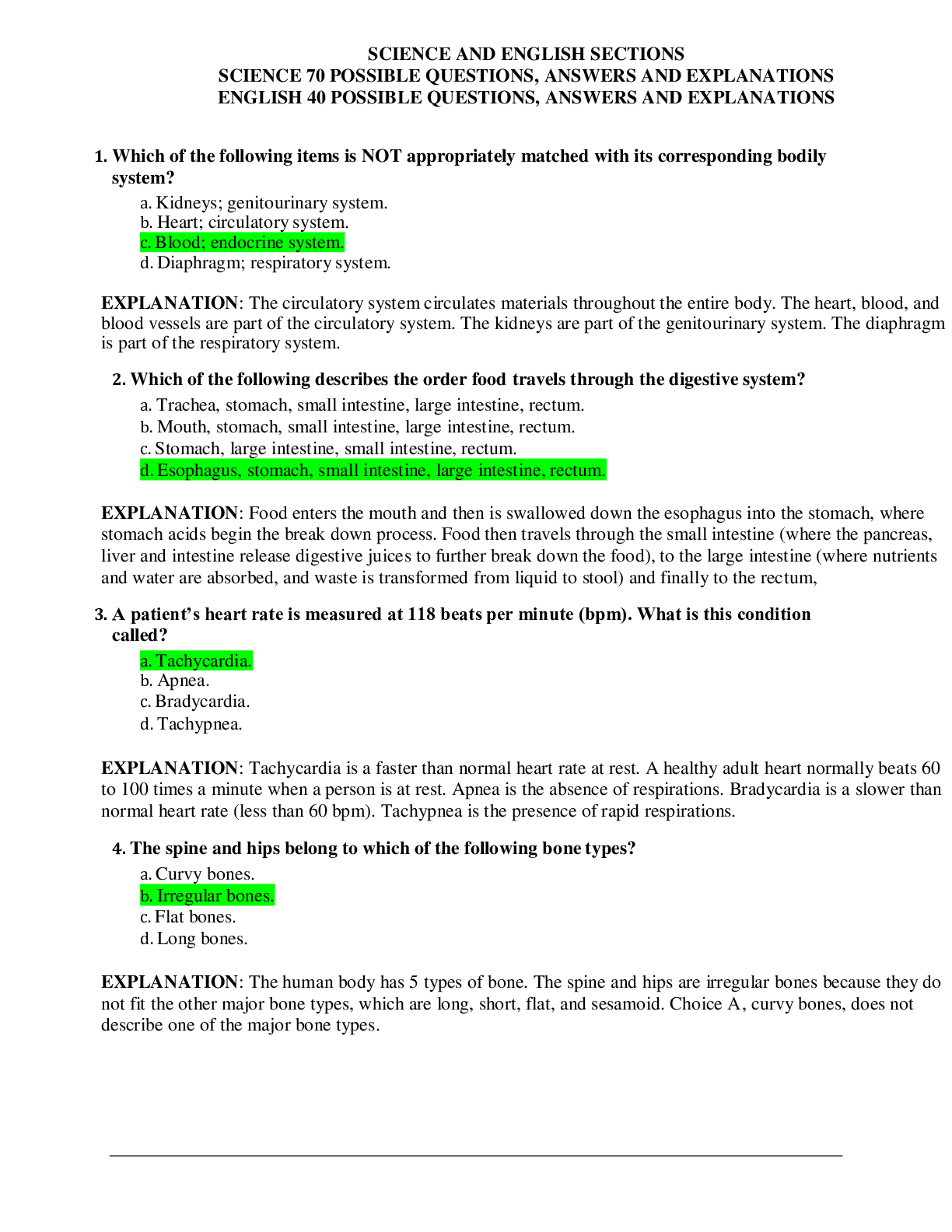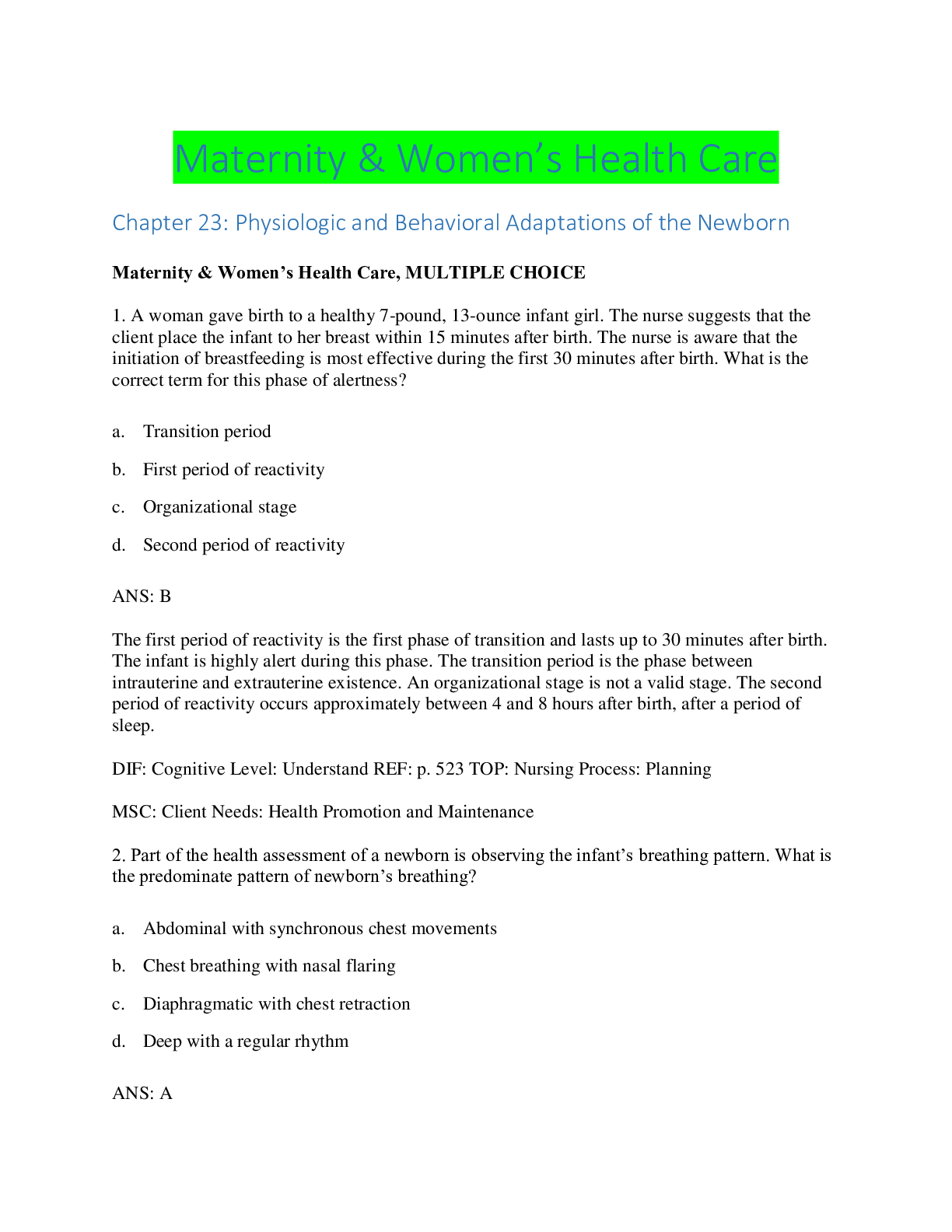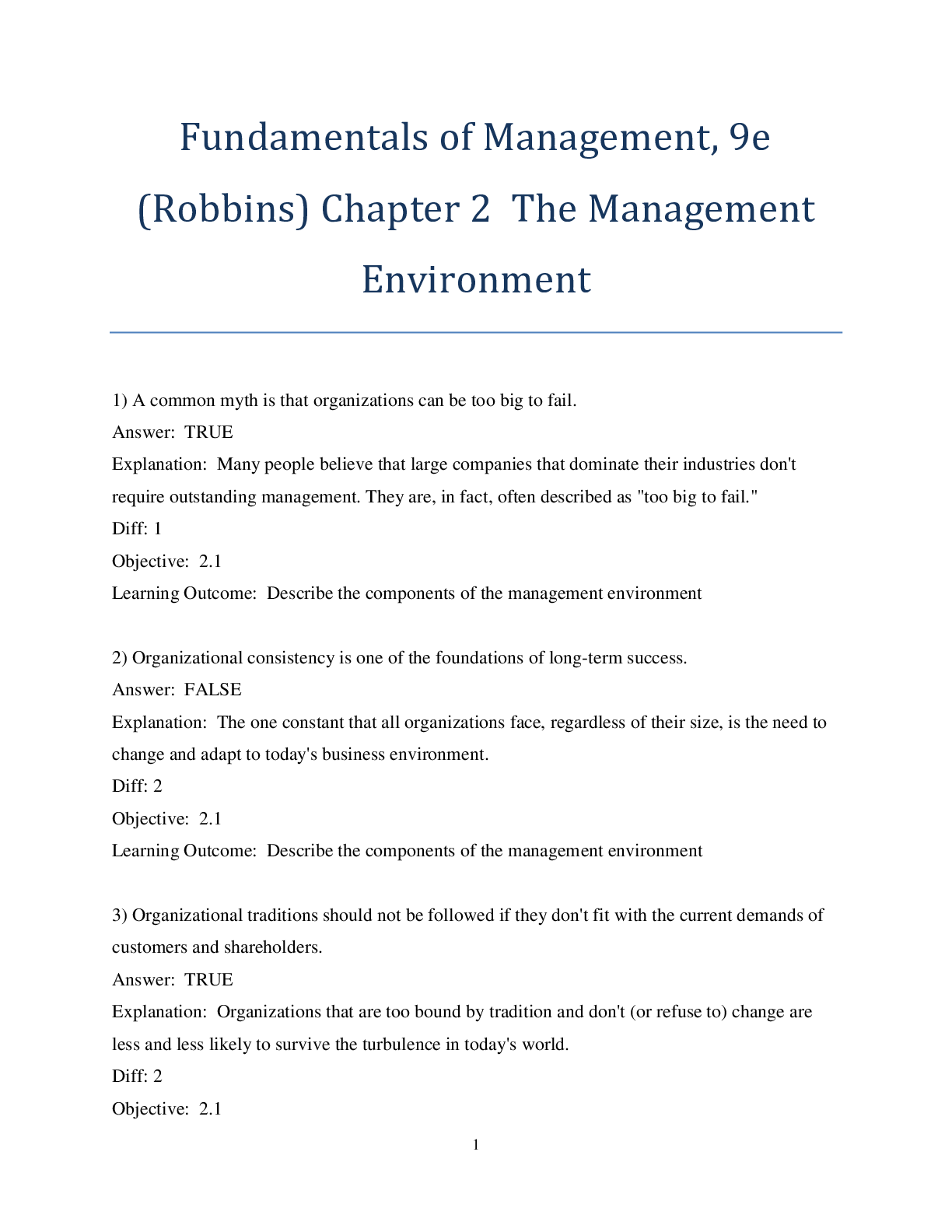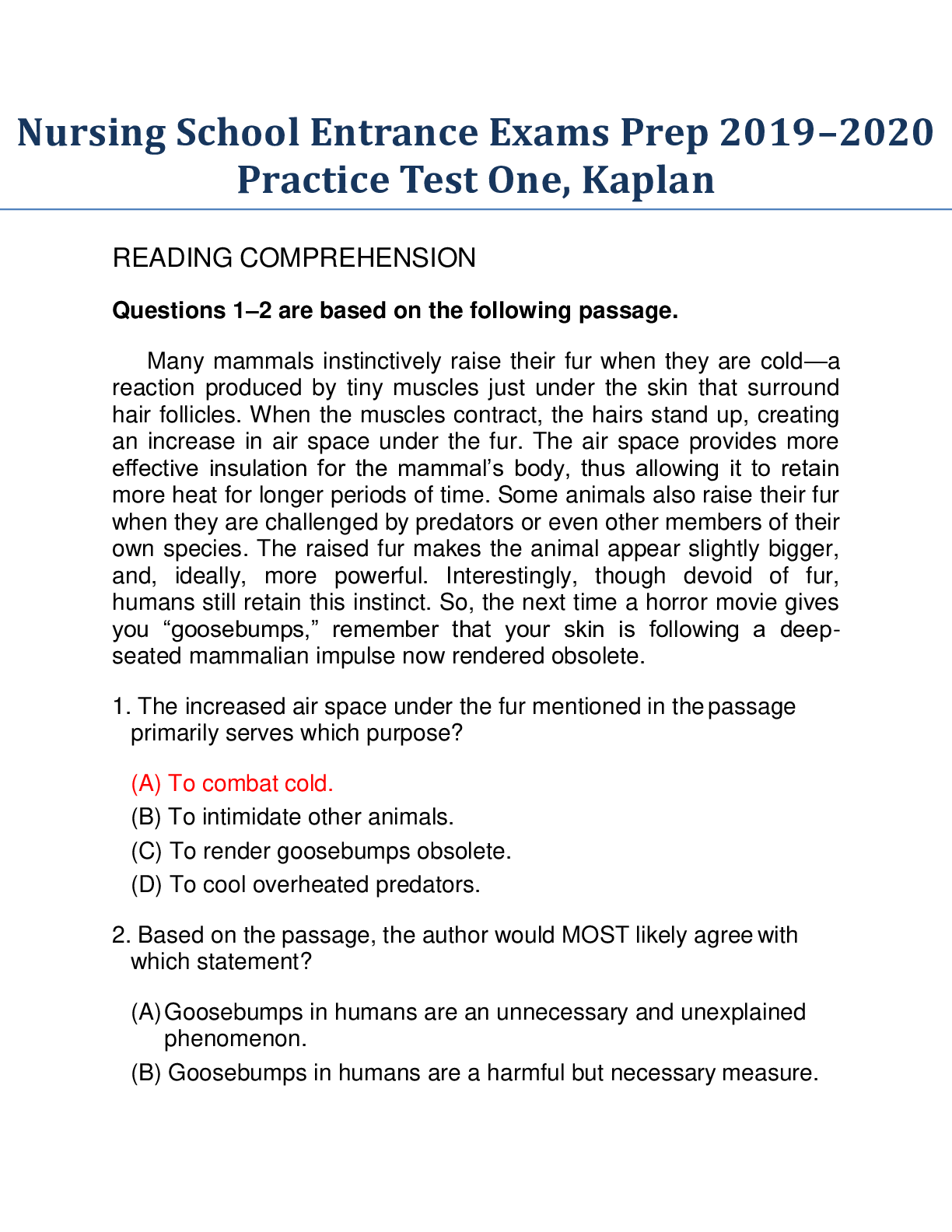*NURSING > QUESTIONS & ANSWERS > SCIENCE AND ENGLISH SECTIONS SCIENCE 70 POSSIBLE QUESTIONS, ANSWERS AND EXPLANATIONS ENGLISH 40 POSS (All)
SCIENCE AND ENGLISH SECTIONS SCIENCE 70 POSSIBLE QUESTIONS, ANSWERS AND EXPLANATIONS ENGLISH 40 POSSIBLE QUESTIONS, ANSWERS AND EXPLANATIONS
Document Content and Description Below
1. Which of the following items is NOT appropriately matched with its corresponding bodily system? a. Kidneys; genitourinary system. b. Heart; circulatory system. c. Blood; endocrine system. d. D... iaphragm; respiratory system. EXPLANATION: The circulatory system circulates materials throughout the entire body. The heart, blood, and blood vessels are part of the circulatory system. The kidneys are part of the genitourinary system. The diaphragm is part of the respiratory system. 2. Which of the following describes the order food travels through the digestive system? a. Trachea, stomach, small intestine, large intestine, rectum. b. Mouth, stomach, small intestine, large intestine, rectum. c. Stomach, large intestine, small intestine, rectum. d. Esophagus, stomach, small intestine, large intestine, rectum. EXPLANATION: Food enters the mouth and then is swallowed down the esophagus into the stomach, where stomach acids begin the break down process. Food then travels through the small intestine (where the pancreas, liver and intestine release digestive juices to further break down the food), to the large intestine (where nutrients and water are absorbed, and waste is transformed from liquid to stool) and finally to the rectum, 3. A patient’s heart rate is measured at 118 beats per minute (bpm). What is this condition called? a. Tachycardia. b. Apnea. c. Bradycardia. d. Tachypnea. EXPLANATION: Tachycardia is a faster than normal heart rate at rest. A healthy adult heart normally beats 60 to 100 times a minute when a person is at rest. Apnea is the absence of respirations. Bradycardia is a slower than normal heart rate (less than 60 bpm). Tachypnea is the presence of rapid respirations. 4. The spine and hips belong to which of the following bone types? a. Curvy bones. b. Irregular bones. c. Flat bones. d. Long bones. EXPLANATION: The human body has 5 types of bone. The spine and hips are irregular bones because they do not fit the other major bone types, which are long, short, flat, and sesamoid. Choice A, curvy bones, does not describe one of the major bone types. SCIENCE AND ENGLISH SECTIONS SCIENCE 70 POSSIBLE QUESTIONS, ANSWERS AND EXPLANATIONS ENGLISH 40 POSSIBLE QUESTIONS, ANSWERS AND EXPLANATIONS The next two questions pertain to the following passage: Your class is competing with another class to determine who has the best plant color. Your class decides to test a couple of solutions to determine which would be best for overall plant color before competing. The class decides to water the plants once a week with 200 mL of the following solutions: water, diet soda, 1% bleach solution, and a 1% salt solution. All plants are placed in the window that receives the recommended amount of light. After a month of testing, your class notices that only two plants are alive, but one of those two does not look healthy. 5. Based on the results that were stated, what would be a logical reason for some of the plants dying with the salt solution? a. Salt caused the plants to begin to dry up, causing them to die. b. The salt did not affect the plants. c. The salt provided adequate nutrients for color. d. None of the above EXPLANATION: Salt would have acted as a dehydrating agent on the plants, causing them to dry out, and therefore, they would have died. 6. Which of the following statements is accurate? a. The spine is located posteriorly, inferior to the pelvic bone. b. The sternum is located anteriorly, superior to the pelvic bone. c. The mandible is located superior to the nasal cavity, and inferior to the esophagus. d. The femur is located inferior to the tibia. EXPLANATION: The sternum is located anteriorly (in the front of the body), superior (above) the pelvic bone. The spine is located posteriorly (in the back of the body), superior, not inferior, to the pelvic bone. The mandible is located inferior to the nasal cavity, and superior to the esophagus. The femur is located superior to the tibia. 7. What are the cellular functions of cilia and flagella? a. Cilia and flagella are responsible for cell movement. b. Cilia and flagella synthesize proteins. c. Cilia and flagella help protect the cell from its environment. d. Cilia and flagella have enzymes that help with digestion. EXPLANATION: Cilia and flagella are responsible for cell movement. Ribosomes are organelles that help synthesize proteins within the cell. The cell membrane helps the cell maintain its shape and protects it from the environment. Lysosomes have digestive enzymes. 8. How does meiosis differ from mitosis? a. Meiosis is used to repair the body. Mitosis is used to break down the body. b. Meiosis is used for asexual reproduction of single-celled organisms. Mitosis is used for sexual reproduction of multicellular organisms. c. Meiosis only occurs in humans. Mitosis only occurs in plants. d.Meiosis produces cells that are genetically different. Mitosis produces cells that are genetically identical. SCIENCE AND ENGLISH SECTIONS SCIENCE 70 POSSIBLE QUESTIONS, ANSWERS AND EXPLANATIONS ENGLISH 40 POSSIBLE QUESTIONS, ANSWERS AND EXPLANATIONS EXPLANATION: Meiosis produces cells that are genetically different, having half the number of chromosomes of the parent cells. Mitosis produces cells that are genetically identical; daughter cells have the exact same number of chromosomes as parent cells. Mitosis is useful for repairing the body while meiosis is useful for sexual reproduction. 9. Which of the following is NOT a function of the integumentary system? a. Protects internal tissues from injury. b. Waterproofs the body. c. Helps regulate body temperature. d. Returns fluid to the blood vessels. EXPLANATION: The integumentary system (skin) protects internal tissues from injury, waterproofs the body, and helps regulate the body’s temperature. The lymphatic system, not the integumentary system, returns fluid to the blood vessels. 10. Which of the following inappropriately describes hemoglobin? a. Hemoglobin transports oxygen from the lungs to the rest of the body. b. Hemoglobin is the ratio of red blood cells to total blood volume. c. Hemoglobin is a type of protein found in red blood cells of all mammals. d. Hemoglobin is the portion of the red blood cell that contains iron, to which oxygen binds. EXPLANATION: Hemoglobin is a type of protein found in the red blood cells of all mammals. It is the portion of the red blood cell that contains iron, to which oxygen binds and then is transported from the lungs to the rest of the body. Hematocrit is the ratio of red blood cells to the total blood volume. The next two questions are based on the following information. A person with the T gene will be tall and a person with the t gene will be short. A person with the B gene will have black hair and a person with the b gene will have red hair. Now consider the Punnett square below. T t B Possibility 1 Possibility 2 b Possibility 3 Possibility 4 11. What are the characteristics of the person with genes from possibility 3? a. Short with black hair. b. Short with red hair. c. Tall with black hair. d. Tall with red hair. EXPLANATION: The complete Punnett square is shown below. T t SCIENCE AND ENGLISH SECTIONS SCIENCE 70 POSSIBLE QUESTIONS, ANSWERS AND EXPLANATIONS ENGLISH 40 POSSIBLE QUESTIONS, ANSWERS AND EXPLANATIONS B TB tB b Tb tb Possibility 3 corresponds to a person with the Tb gene combination, which means the person is tall with red hair. 12. Which possibility would produce a short offspring with black hair? a. Possibility 1. b. Possibility 2. c. Possibility 3. d. Possibility 4. EXPLANATION: Refer to the complete Punnett square in the explanation for question 25. Possibility 2 corresponds to the tB pair of genes, which is short with black hair. 13. Fill in the blanks in the following sentence: Enzymes are ________ molecules that serve as ___for certain biological reactions. a. irrelevant; suppressors b. acidic; catalysts c. lipid; catalysts d. protein; catalysts EXPLANATION: Enzymes are protein molecules that serve as catalysts for certain biological reactions. Enzymes are not acids or lipids. Enzymes are definitely relevant for living organisms and do not suppress reactions. 14. What type of chemical bond connects the oxygen and hydrogen atoms in a molecule of water? a. Static bond. b. Aquatic bond. c. Ionic bond. d. Covalent bond. EXPLANATION: A covalent bond is one in which atoms share valence electrons. Within a water molecule, one oxygen atom and two hydrogen atoms share valence electrons to yield the H2O structure. 15. Which of the following statements describes a chemical property of water? a. Water has a pH of 1. b. A water molecule contains 2 hydrogen atoms and 1 oxygen atom. c. A water molecule contains 2 oxygen atoms and 1 hydrogen atom. d. The chemical formula for water is HO2. EXPLANATION: A water molecule contains 2 hydrogen atoms and 1 oxygen atom. Therefore, the chemical formula for water is H2O. The pH of water is 7. SCIENCE AND ENGLISH SECTIONS SCIENCE 70 POSSIBLE QUESTIONS, ANSWERS AND EXPLANATIONS ENGLISH 40 POSSIBLE QUESTIONS, ANSWERS AND EXPLANATIONS 16. An atom has 2 protons, 4 neutrons, and 2 electrons. What is the approximate atomic mass of this atom? a. 2. b. 4. c. 6. d. 8. EXPLANATION: The atomic mass of an atom is approximately equal to the number of protons plus the number of neutrons, in this case, 6. The weight of the electrons has little effect on the overall atomic mass. 17. Which of the following is true regarding T cells? a. They are only seen in those with leukemia. b. They are a specialized type of red blood cell. c. They mature in the thyroid. d. They play a role in the immune response. EXPLANATION: T cells are a specialized type of white blood cells that play an important role in the immune response of all humans. They help destroy pathogens in the body and initiate the body’s immune response to fight the infection. T cells are produced in the bone marrow, but they mature in the thymus gland. 18. The table below contains information from the periodic table of elements. Element Atomic number Approximate atomic weight B 5 11 C 6 12 N 7 14 O 8 16 Which pattern below best describes the masses of the elements listed in the table? a. The elements are listed in random order, C being the heaviest element and N being the lightest element. b.The elements are listed in decreasing order, B being the heaviest element and O being the lightest element. c. The elements are listed in increasing order, B being the lightest element and O being the heaviest element. d. All the elements weigh the same, so the order is irrelevant. EXPLANATION: The atomic weight tells the mass of the element. In the table, B is the lightest element, weighing 11 atomic mass units, and O is the heaviest element, weighing 16 atomic mass units. 19. Which of the following lists the normal blood flow through the heart? a. Left ventricle, left atria, body, right ventricle, right atrium, lungs. b. Left atrium, left ventricle, lungs, right atrium, right ventricle, body. c. Right atrium, right ventricle, lungs, left atrium, left ventricle, body. d. Right ventricle, right atria, body, left atrium, left ventricle, lungs. EXPLANATION: The right atrium receives deoxygenated blood from the body which flows into the right ventricle. From there, the blood goes to the lungs where it becomes oxygenated. The left atrium receives SCIENCE AND ENGLISH SECTIONS SCIENCE 70 POSSIBLE QUESTIONS, ANSWERS AND EXPLANATIONS ENGLISH 40 POSSIBLE QUESTIONS, ANSWERS AND EXPLANATIONS oxygenated blood and pumps it to the left ventricle which distributes it to the rest of the body. 20. Which of the following functions is not controlled by the autonomic nervous system? a. Digestion. b. Walking. c. Heartbeat. d. Temperature regulation. EXPLANATION: Walking is not controlled by the autonomic nervous system. The autonomic nervous system regulates involuntary body processes such as heartbeat, blood pressure, respirations, digestion, metabolism, and elimination of toxins. Walking is controlled by the somatic system which helps control skeletal muscle voluntary control. 21. A dietitian wants to convince a patient to lose weight. Which statement below best communicates a scientific argument that justifies the need for weight loss? a. Losing weight can lower blood pressure, increase energy level, and promote overall health. b. Society tends to treat overweight people unfairly. c. Members of the opposite sex are more interested in people who maintain a healthy weight. d. Losing weight is easy to do. EXPLANATION: A scientific argument should discuss outcomes that are objective and measurable, such as blood pressure, energy level, and overall health. The other choices present arguments that are subjective and based on emotions instead of facts. 22. Which of the following is NOT a function of the circulatory system? a. Pumping blood throughout the body to provide tissues and organs with nutrients and oxygen. b. Removing toxins and waste from the blood c. Transmitting nerve impulses between the brain and the rest of the body. d. Transporting important hormones released from glands to their sites of action. EXPLANATION: The circulatory system consists of the heart, blood vessels, lymph, lymph nodes, and blood. It circulates materials throughout the entire body, providing tissues and organs with nutrients and oxygen. It is also responsible for transporting hormones and removing waste. The nervous system is responsible for transmitting nerve impulses that originate in the brain and coordinate action in the rest of the body. 23. Which of the following cells is NOT part of the immune system? a. Neurons. b. Dendritic cells. c. Macrophages. d. Mast cells. EXPLANATION: The immune system helps protect the body from bacteria, viruses, infections, and other elements that could cause illness. Depending on the foreign element that enters the body, different cells respond to attack the foreign element. Cells that contribute to this protection and response include leukocytes, or white blood cells (eosinophils, basophils, natural killer (NK) cells, and mast cells), and phagocytic cells (dendritic cells, macrophages and neutrophils) in addition to cells of adaptive immunity (B cells and T cells) which are produced SCIENCE AND ENGLISH SECTIONS SCIENCE 70 POSSIBLE QUESTIONS, ANSWERS AND EXPLANATIONS ENGLISH 40 POSSIBLE QUESTIONS, ANSWERS AND EXPLANATIONS in the bone marrow. A neuron is a nerve cell that is central to the nervous system and transmits nerve impulses. 24. Which of the following is NOT one of the major types of bones in the human body? a. Dense bone. b. Long bone. c. Short bone. d. Irregular bone. EXPLANATION: The human body has five types of bones: long bones, short bones, irregular bones, flat bones, and sesamoid bones. While bones may be dense, this is not a major category of bones in the body. 25. Which of the following bone types is embedded in tendons? a. Long bones. b. Sesamoid bones. c. Flat bones. d. Vertical bones. EXPLANATION: Sesamoid bones are embedded in tendons. Vertical bones, is not a major bone type. Long bones contain a long shaft, and flat bones are thin and curved. SCIENCE AND ENGLISH SECTIONS SCIENCE 70 POSSIBLE QUESTIONS, ANSWERS AND EXPLANATIONS ENGLISH 40 POSSIBLE QUESTIONS, ANSWERS AND EXPLANATIONS 26. Which of the following is not a product of respiration? a. Carbon dioxide. b. Water. c. Oxygen. d. ATP. EXPLANATION: In respiration, the human inhales air, consisting of oxygen, and then produces energy (ATP) and exhales nitrogen, carbon dioxide, and water (in the form of vapor). While oxygen is a main component of the respiratory system’s process, it is not produced by the respiratory system. Rather, it is utilized and distributed throughout the body, and then what is not absorbed, is exhaled back into the environment. 27. Of the following, the blood vessel containing the least-oxygenated blood is: a. the aorta. b. the vena cava. c. the pulmonary artery. d. the capillaries. EXPLANATION: The pulmonary artery carries oxygen-depleted blood from the heart to the lungs, where CO2 is released and the supply of oxygen is replenished. This blood then returns to the heart through the pulmonary vein, and is carried through the aorta and a series of branching arteries to the capillaries, where the bulk of gas exchange with the tissues occurs. Oxygendepleted blood returns to the heart through branching veins (the femoral veins bring it from the legs) into the vena cava, which carries it again to the heart. Since the pulmonary artery is the last step before replenishment of the blood’s oxygen content, it contains the blood which is the most oxygen depleted. 28. Which layer of the heart contains striated muscle fibers for contraction of the heart? a. Pericardium. b. Epicardium. c. Endocardium. d. Myocardium. EXPLANATION: The myocardium is the layer of the heart that contains the muscle fibers responsible for contraction (Hint: myo- is the prefix for muscle). The endocardium and epicardium are the inner and outer layers of the heart wall, respectively. The pericardium is the sac in which the heart sits inside the chest cavity. 29. Mrs. Jones’s class conducted an experiment on the effects of sugar and artificial sweetener on the cookie recipe’s overall color when baked. What would be the independent variable in the cookie experiment? a. The students should use the same ingredients in both recipes, but bake the cookies with sugar at 450 degrees and those with artificial sweetener at 475 SCIENCE AND ENGLISH SECTIONS SCIENCE 70 POSSIBLE QUESTIONS, ANSWERS AND EXPLANATIONS ENGLISH 40 POSSIBLE QUESTIONS, ANSWERS AND EXPLANATIONS degrees. They should increase the baking time on the artificial sweetener cookies, since the package instructs them to do so. b. The students should use the same ingredients in both recipes, but increase the baking timeon the artificial sweetener cookies, since the package instructs them to do so. c. The students should use the same ingredients, same baking temperatures, and same baking times for both recipes. d. The students should use the same ingredients and baking times in both recipes, but bake the cookies with sugar at 450 degrees and the artificial sweetener cookies at 475 degrees. EXPLANATION: The independent variable is the variable that is changed in the experiment in order to determine its effect on the dependent variable or the outcome of the experiment. The dependent variable results from the experimenter making only one change to an experiment that can be repeated with the same results. Mrs. Jones’s class was comparing the effects of sugar and artificial sweetener on the overall color of cookies once they are baked; thus, the one thing that should be changed in the experiment is the sugar and artificial sweetener in the recipe. All of the other ingredients stay the same. For the experiment to be valid and not influenced by any other variables, the students should keep the temperature and baking time the same, as these could affect the color of the cookies as well. 30. What function do ribosomes serve within the cell? a. Ribosomes are responsible for cell movement. b. Ribosomes aid in protein synthesis. c. Ribosomes help protect the cell from its environment. d. Ribosomes have enzymes that help with digestion. EXPLANATION: Ribosomes are organelles that help synthesize proteins within the cell. Cilia and flagella are responsible for cell movement. The cell membrane helps the cell maintain its shape and protects it from the environment. Lysosomes have digestive enzymes. 31. How is meiosis similar to mitosis? a. Both produce daughter cells that are genetically identical. b. Both produce daughter cells that are genetically different. c. Both occur in humans, animals, and plants. d. Both occur asexually. EXPLANATION: Both meiosis and mitosis occur in humans, animals, and plants. Mitosis produces cells that are genetically identical, and meiosis produces cells that are genetically different. Only mitosis occurs asexually. SCIENCE AND ENGLISH SECTIONS SCIENCE 70 POSSIBLE QUESTIONS, ANSWERS AND EXPLANATIONS ENGLISH 40 POSSIBLE QUESTIONS, ANSWERS AND EXPLANATIONS [Show More]
Last updated: 2 years ago
Preview 1 out of 40 pages

Buy this document to get the full access instantly
Instant Download Access after purchase
Buy NowInstant download
We Accept:

Reviews( 0 )
$10.00
Can't find what you want? Try our AI powered Search
Document information
Connected school, study & course
About the document
Uploaded On
Jun 12, 2021
Number of pages
40
Written in
Additional information
This document has been written for:
Uploaded
Jun 12, 2021
Downloads
0
Views
50


























